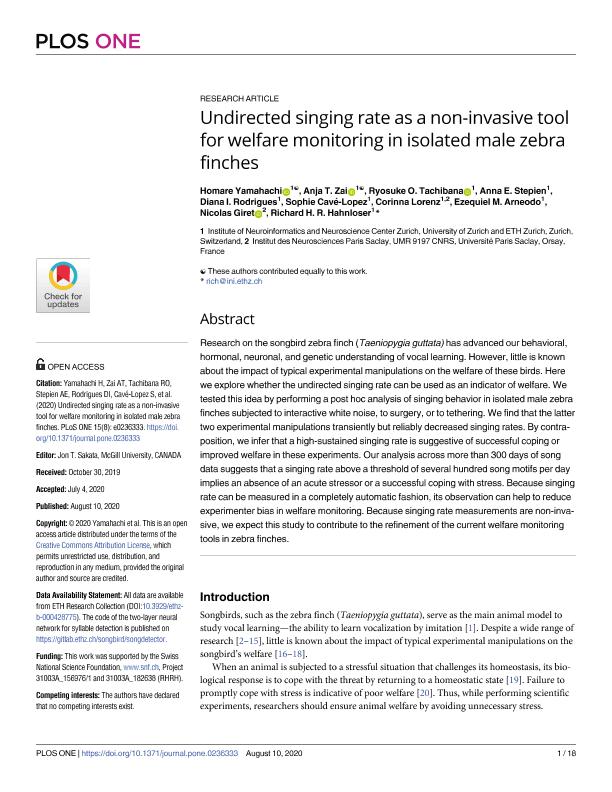Mostrar el registro sencillo del ítem
dc.contributor.author
Yamahachi, Homare
dc.contributor.author
Zai, Anja T.
dc.contributor.author
Tachibana, Ryosuke O.
dc.contributor.author
Stepien, Anna E.
dc.contributor.author
Rodrigues, Diana I.
dc.contributor.author
Cavé Lopez, Sophie
dc.contributor.author
Lorenz, Corinna
dc.contributor.author
Arneodo, Ezequiel Matías

dc.contributor.author
Giret, Nicolas
dc.contributor.author
Hahnloser, Richard H. R.
dc.date.available
2021-10-27T04:40:13Z
dc.date.issued
2020-08
dc.identifier.citation
Yamahachi, Homare; Zai, Anja T.; Tachibana, Ryosuke O.; Stepien, Anna E.; Rodrigues, Diana I.; et al.; Undirected singing rate as a non-invasive tool for welfare monitoring in isolated male zebra finches; Public Library of Science; Plos One; 15; 8; 8-2020; 1-18
dc.identifier.issn
1932-6203
dc.identifier.uri
http://hdl.handle.net/11336/145152
dc.description.abstract
Research on the songbird zebra finch (Taeniopygia guttata) has advanced our behavioral, hormonal, neuronal, and genetic understanding of vocal learning. However, little is known about the impact of typical experimental manipulations on the welfare of these birds. Here we explore whether the undirected singing rate can be used as an indicator of welfare. We tested this idea by performing a post hoc analysis of singing behavior in isolated male zebra finches subjected to interactive white noise, to surgery, or to tethering. We find that the latter two experimental manipulations transiently but reliably decreased singing rates. By contraposition, we infer that a high-sustained singing rate is suggestive of successful coping or improved welfare in these experiments. Our analysis across more than 300 days of song data suggests that a singing rate above a threshold of several hundred song motifs per day implies an absence of an acute stressor or a successful coping with stress. Because singing rate can be measured in a completely automatic fashion, its observation can help to reduce experimenter bias in welfare monitoring. Because singing rate measurements are non-invasive, we expect this study to contribute to the refinement of the current welfare monitoring tools in zebra finches.
dc.format
application/pdf
dc.language.iso
eng
dc.publisher
Public Library of Science

dc.rights
info:eu-repo/semantics/openAccess
dc.rights.uri
https://creativecommons.org/licenses/by/2.5/ar/
dc.subject
Birdsong
dc.subject
Animal welfate
dc.subject
Functional electrical stimulation
dc.subject
Electrophysiology
dc.subject.classification
Ecología

dc.subject.classification
Ciencias Biológicas

dc.subject.classification
CIENCIAS NATURALES Y EXACTAS

dc.title
Undirected singing rate as a non-invasive tool for welfare monitoring in isolated male zebra finches
dc.type
info:eu-repo/semantics/article
dc.type
info:ar-repo/semantics/artículo
dc.type
info:eu-repo/semantics/publishedVersion
dc.date.updated
2021-09-06T17:47:45Z
dc.journal.volume
15
dc.journal.number
8
dc.journal.pagination
1-18
dc.journal.pais
Estados Unidos

dc.journal.ciudad
San Francisco
dc.description.fil
Fil: Yamahachi, Homare. Universitat Zurich; Suiza
dc.description.fil
Fil: Zai, Anja T.. Universitat Zurich; Suiza
dc.description.fil
Fil: Tachibana, Ryosuke O.. Universitat Zurich; Suiza
dc.description.fil
Fil: Stepien, Anna E.. Universitat Zurich; Suiza
dc.description.fil
Fil: Rodrigues, Diana I.. Universitat Zurich; Suiza
dc.description.fil
Fil: Cavé Lopez, Sophie. Universitat Zurich; Suiza
dc.description.fil
Fil: Lorenz, Corinna. Universite Paris Saclay; Francia. Universitat Zurich; Suiza
dc.description.fil
Fil: Arneodo, Ezequiel Matías. Universitat Zurich; Suiza. Consejo Nacional de Investigaciones Científicas y Técnicas. Centro Científico Tecnológico Conicet - La Plata. Instituto de Física La Plata. Universidad Nacional de La Plata. Facultad de Ciencias Exactas. Instituto de Física La Plata; Argentina
dc.description.fil
Fil: Giret, Nicolas. Universite Paris Saclay; Francia
dc.description.fil
Fil: Hahnloser, Richard H. R.. Universitat Zurich; Suiza
dc.journal.title
Plos One

dc.relation.alternativeid
info:eu-repo/semantics/altIdentifier/doi/http://dx.doi.org/10.1371/journal.pone.0236333
dc.relation.alternativeid
info:eu-repo/semantics/altIdentifier/url/https://journals.plos.org/plosone/article?id=10.1371/journal.pone.0236333
Archivos asociados
